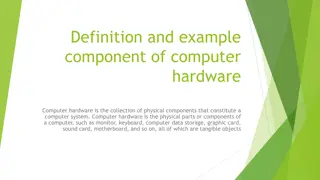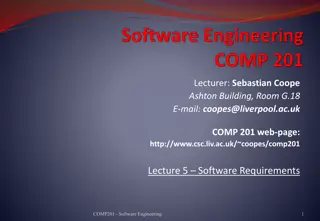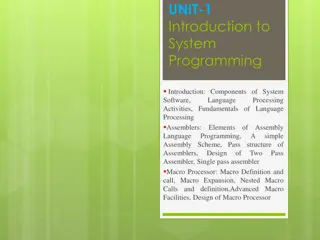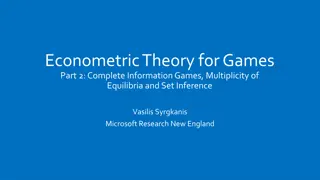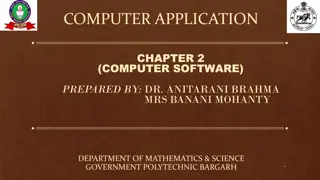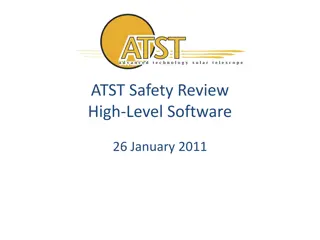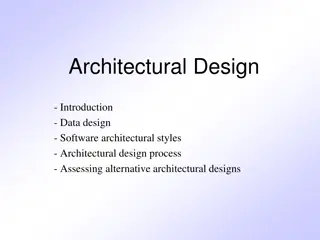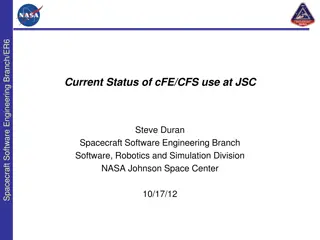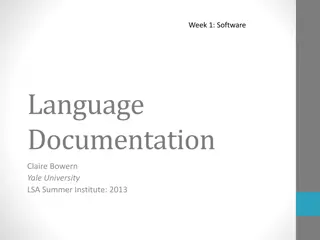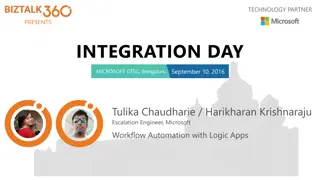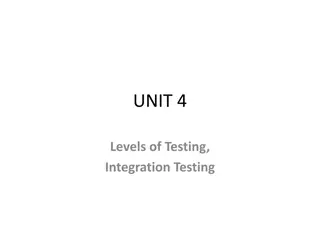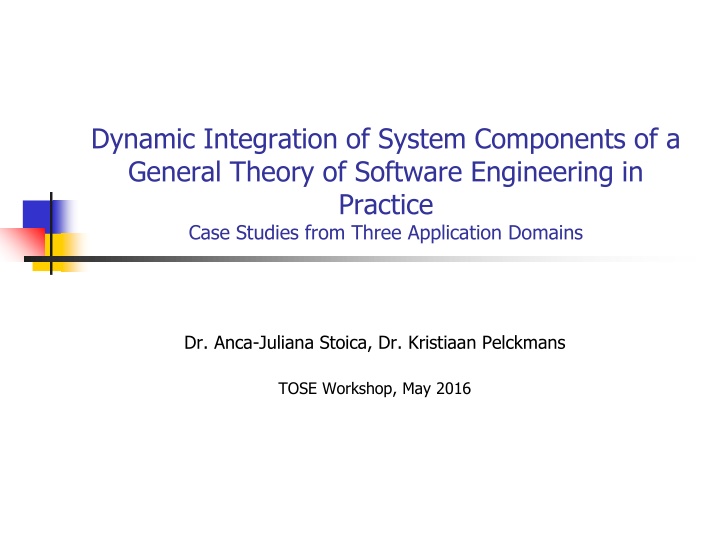
Dynamic Integration of System Components of a General Theory of Software Engineering in Practice
This paper by Dr. Anca-Juliana Stoica explores the practical implementation of a general software engineering theory through case studies in three different application domains. It delves into the dynamic integration of system components to provide insights and lessons learned for software development professionals.
Download Presentation

Please find below an Image/Link to download the presentation.
The content on the website is provided AS IS for your information and personal use only. It may not be sold, licensed, or shared on other websites without obtaining consent from the author. If you encounter any issues during the download, it is possible that the publisher has removed the file from their server.
You are allowed to download the files provided on this website for personal or commercial use, subject to the condition that they are used lawfully. All files are the property of their respective owners.
The content on the website is provided AS IS for your information and personal use only. It may not be sold, licensed, or shared on other websites without obtaining consent from the author.
E N D
Presentation Transcript
Dynamic Integration of System Components of a General Theory of Software Engineering in Practice Case Studies from Three Application Domains Dr. Anca-Juliana Stoica, Dr. Kristiaan Pelckmans TOSE Workshop, May 2016
Outline System Components of a General Theory of Software Engineering Real World Case Studies A. Strategies and Challenges in Designing Communication Solutions for Large-Scale Events B. Hybrid Development of Mobile Applications with Software Quality Focus C. Building Internet Communities for Students A Managerial Perspective Conclusions and Quality Criteria 2
System Components of a General Theory of Software Engineering Stoica, Pelckmans, Rowe - Science of Computer Programming 101,(2015) 42-65
Model System Concept Models: an abstract description to visualise and reason about the system and its effects. Views: selected aspects needed to make informed decisions. Model System: Collection of interconnected and consistent components that work together for defining/developing/delivering a software system. Actors: Stakeholders. Developers. Users. Product model: Requirement view. Specification view. Design view. Architectural view. Real-time design view. Evaluation: Success model. Property models. Environment model. Decision Framework.
Model System Delivered Software System Changing Requirements 5
Software Engineering Models A model is a pattern of something to be made, a description or an analogy used to visualize and reason about the system to be developed and its likely effects Models are built to help focus on the appropriate set of questions that need answering in order to find the most reliable and cost-effective solutions and to qualify the system against its stakeholders views 6
Model Systems Benefits: i) model the software development facets and are also used to build the software; ii) allow reasoning, optimization, and decision analysis Require: model clash analysis in order to validate model compatibility Please note the difference between model systems (an emergent concept) and system models (a traditional software engineering concept which essentially applies only to models of the system to be built, like e.g. behavioral, semantic data, or object models) 7
Decision Framework Decision-under-risk theoretic [von Neumann & Morgenstern, 1944]. Explicit notion of time in the SE process. Explicit notion of utility in the SE process. Explicit factoring in of risks and uncertainties in the SE process. Represent the software decision- under-risk process as a discrete dynamic decision tree (DDT):
Decision Framework Central governance component for a given software engineering endeavor Effectively managing risks and uncertainties related to project success in the building stage Design process in an economic perspective: Value of Waiting (VOW) , Value of Information (VOI), and possible outcomes can be coped with explicitly Optimal control of modern adaptive software development: dynamic programming; optimal sequence of decisions while developing an overall framework in which these techniques compatibly reinforce each other. 9
Outline System Components of a General Theory of Software Engineering Real World Case Studies A. Strategies and Challenges in Designing Communication Solutions for Large-Scale Events B. Hybrid Development of Mobile Applications with Software Quality Focus C. Building Internet Communities for Students A Managerial Perspective Conclusions and Quality Criteria 10
Introduction to Case Studies Exploratory real-world case studies and their content Research questions associated with them Contributions of applying SC GTSE in practice Developers adapted to the problem statement their design style, process, property, and success models Mayor decisions in early project stages and/or high-level design decisions (such as: early architectural design, development platforms, system components, , success criteria, process, system properties) are governed and optimally controlled by the success- critical stakeholders and the application of the decision framework Use of blended techniques from plan-driven and agile methods Cover a wide range of application domains. Limitations as in most case studies, results are not statistically generalizable across any particular industry or group, but Results are theoretically generalizable because they support specific theoretical conjectures. 11
Study (analyze) communication systems for re-occurring, time-limited and geographically focused, large-scale events. What kind of demands these large-scale events put on communication systems? Understand the environment of Large Scale Public Events Understand the complex interactions of different stakeholders and their requirements connected to the communication system Develop new secure and reliable communication system for large scale public events, satisfying stakeholders requirements Enhance the experience of visitors attending large-scale events using modern telecommunications and information technology. 12 Dr. Anca-Juliana Stoica (KTH/ICT)
Internal Organizer's Network - W-LAN s * Check in office Hultsfred.TV s caravan BTH s caravan 802.11b wireless link s * Teaterladan stage Stora dans stage Other office 2 Mbps HDSL line Festival office Ethernet * Legend * = Single PC client with external flat panel antenna Pampas stage Atlantis stage s = slave It is possible to connect most clients to either the extranet or the intranet. The details are left out of this figure. Hawaii stage Orinoco and Compex solutions with external antennas to connect buildings Standard access points for WHAT project roaming and to connect PCs 13 Dr. Anca-Juliana Stoica (KTH/ICT)
System Life-Cycle Model for Uncertain and Turbulent Environments Development Stage Evolution Stage During Event Stakeholder Workshops Analysis- Data Collection & Testing der/Value Stakehol Analysis System After Event Design Analysis- Improvements Real time Stakeholder/ Screen out Analysis Analysis feedback ollecting testing/c Value improve Stakeholder Workshops ments During Event Data Improved Collection & Testing System Real time Screen out testing/colle feedback improveme Prototyping cting After Event Early Archi. Concept nts Screen out Requirements Analysis Improved System Stakeholder Workshops During Event Data Collection & Testing Strategy Before Event Hypothesis Initial investigation Event-Related Time 14 Dr. Anca-Juliana Stoica (KTH/ICT)
Proposed Mobile Operator supported W-LAN Architecture E I R OSS GSM/WCDMA Core Radio Network BGw Management GGSN SGSN V L R WLAN Manager H L R A U C GMSC MSC GSM/WCDMA Radio Network Internet EWAS ASM Bridge AP Hawaii Bridge ASN AP Bridge Router/SG AP Admin AP Teater Parking Bridge AP AP Pampas Bridge Admin Admin Admin AP AP AP Organizers Office Net Bridge AP Admin Shara AP Admin AP AP Camp, FAid Bridge Bridge Admin Rest., FAid AP Atlantus Bridge AP AP Bridge AP S Entre AP Bridge P Entre AP Admin Admin AP AP Admin AP Dr. Anca-Juliana Stoica (KTH/ICT) Admin AP AP 15 Admin AP
Case study A - conclusions We introduced a system development model for uncertain and turbulent environments to prove the feasibility of new technical, service, and business concepts through an iterative approach in which users and other stakeholders participate through the process and demonstrate the expected benefits and advantages of developing new communication systemsarchitecture and mobile multi-media application services, such as location based services and VoIP applications The proposed communication systems/solutions solve key issues: i) organizers want to have one device (end-user terminal) for all communication needs: ii) they also want to maintain only one network that is able to fulfill all their requirements. We proposed W-LAN inter-working with cellular mobile networks that have the capability to solve these issues when Mobile IP based smart phones are used with advanced applications Stakeholder/value dependency framework is useful for reasoning about the communication system s dependability attributes and project scoping The development model and stakeholder dependability analysis are key models to identify the tradeoffs which are necessary in order to provide a dependable system that will evolve to meet future requirement changes and will satisfy the stakeholder/ value dependencies. The FriendFinder location-based application is expected to be one of the most used applications in grand public events and we proposed: i) how and what components need to be added in cellular mobile networks to support it, and ii) the key contributors that must work together in order to successfully built and deploy the application 16
What? Mobile news delivery systems for communication service providers. Front-end and back-end development. Product line development. Challenge Balance the agility and plan driven approaches in software development to take advantage of their strengths in a given situation while compensating for their weaknesses Solutions Software risk management approach Software quality management approach following quality standards (SQuaRE), for structuring projects to incorporate both agile and plan-driven features in proportion to project s needs. Models and frameworks Quality models, metrics and characteristics, project basic data (RSM reports), software quality reports, value-based framework Stoica, A.J. (2007). Exploring Quantitative Yields of Software Engineering Methods in the Software Life-Cycle. The first IEEE Computer Society EQUITY International Conference. 19-21 March 2007, Amsterdam, the Netherlands. 17
Project 1 Project 2 To publish fresh publications, e.g. news articles from news providers, via WAP or GPRS to the customers of a telecommunication company Publications are delivered to application by RSS and server creates pages that are suitable for mobile stations to read. To publish Web Logs (Blogs) via WAP or GPRS to the customers of a telecommunication company Publications are delivered to application by RSS and server creates pages that are suitable for mobile stations to read. Real-life example for hybrid quality driven development with SQuaRE: models, benefits, guidelines, experience base, evaluation framework
Project 1 Used techniques: Feature Driven Development Small team Osmotic communication Spiking, Walking skeleton Information radiators Simple design Access to expert user Estimation using comparison and analogy Frequent delivery Documentation is not so important Kick-off meeting Status reporting
Project 2 Used techniques and models: Feature Driven Development Small team Osmotic communication Spiking, Walking skeleton Information radiators Access to expert user Estimation using comparison and analogy Frequent delivery Kick-off meeting Status reporting Code reviews Measurements of quality characteristics Burn charts Initial reqs spec, admin guide, architecture and design model, quality project plan Quantitative yields and benefits evaluation using value-based framework (model-based)
Value-Based Framework (VF) Interrelated software system metrics and models that address: Costs (CM) Quality (QM) Productivity (WM) Benefits (BM) from applying better software project quality management Resulting value estimation metrics (VM), evaluated over the software life-cycle.
Case study B - Summary Our research shows that there are no conflicts between applying ISO/IEC SQuaRE software quality standards and agile software development Economic and quality benefits are demonstrated using a value framework as well as software metrics and measurements Simple guide to SQuaRE practical use with real-life example is presented Evaluation framework for software system projects to decide on the balance between agile and plan-driven approaches is outlined Experience base for analysing software system projects is created Our work is a step forward in reconciling agile approaches and formal software product quality evaluation that is discussed in ISO/IEC software quality standards.
What is it? A web-based platform for managing student enrolment in courses, and other academic managerial tasks Design to schedule Risk driven development Both front-end (web) and back-end (servers) Hybrid (agile and disciplined) development Process guidelines for managing similar web applications development projects. Application characteristics Scalability (upgrade easily and transparently) Maintainability (bug fixing and feature expansion) Easy to monitor (statistics of system usage) Consistent structure of user interfaces (standardized browsing) Maximize communication points (B2S, S2S, U2S) Increased usability among students, teachers/administrators, student associations, and business world. Model system concepts are applied for the application design, development, and process management. 23
Outline System Components of a General Theory of Software Engineering Real World Case Studies A. Strategies and Challenges in Designing Communication Solutions for Large-Scale Events B. Hybrid Development of Mobile Applications with Software Quality Focus C. Building Internet Communities for Students A Managerial Perspective Conclusions and Quality Criteria 24
Conclusions and Quality Criteria Application and validation of the theory quality criteria presented case studies indicate: quality criteria related to the 1. Relation to real world (case studies) 2. Support good decision making (DF) 3. Formalisms (DF, VF) 4. Consistency (model clash analysis) 5. Measurability (utility, process and product metrics) 6. Predictability (project outcomes, risks and uncertainties) 25


